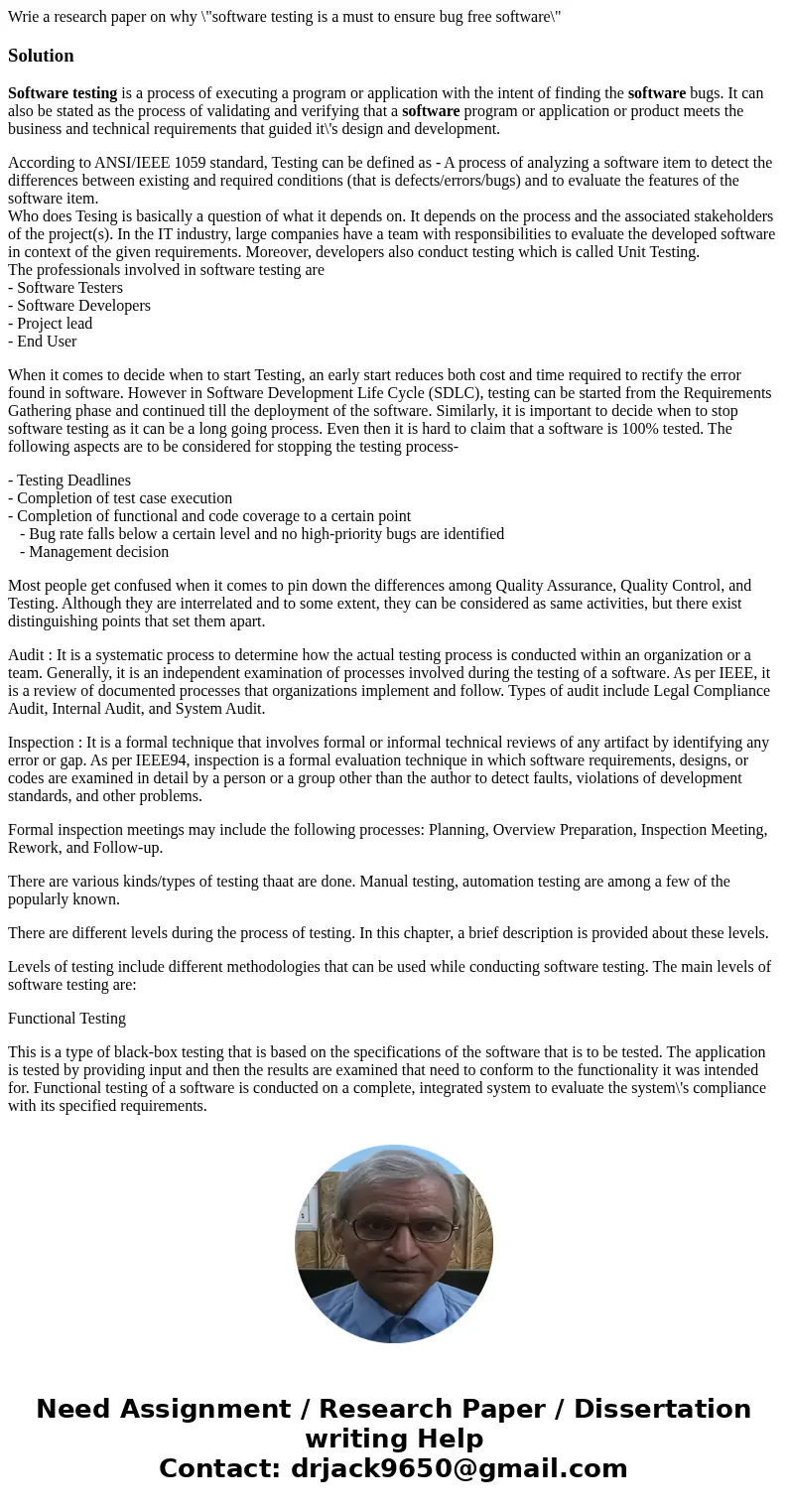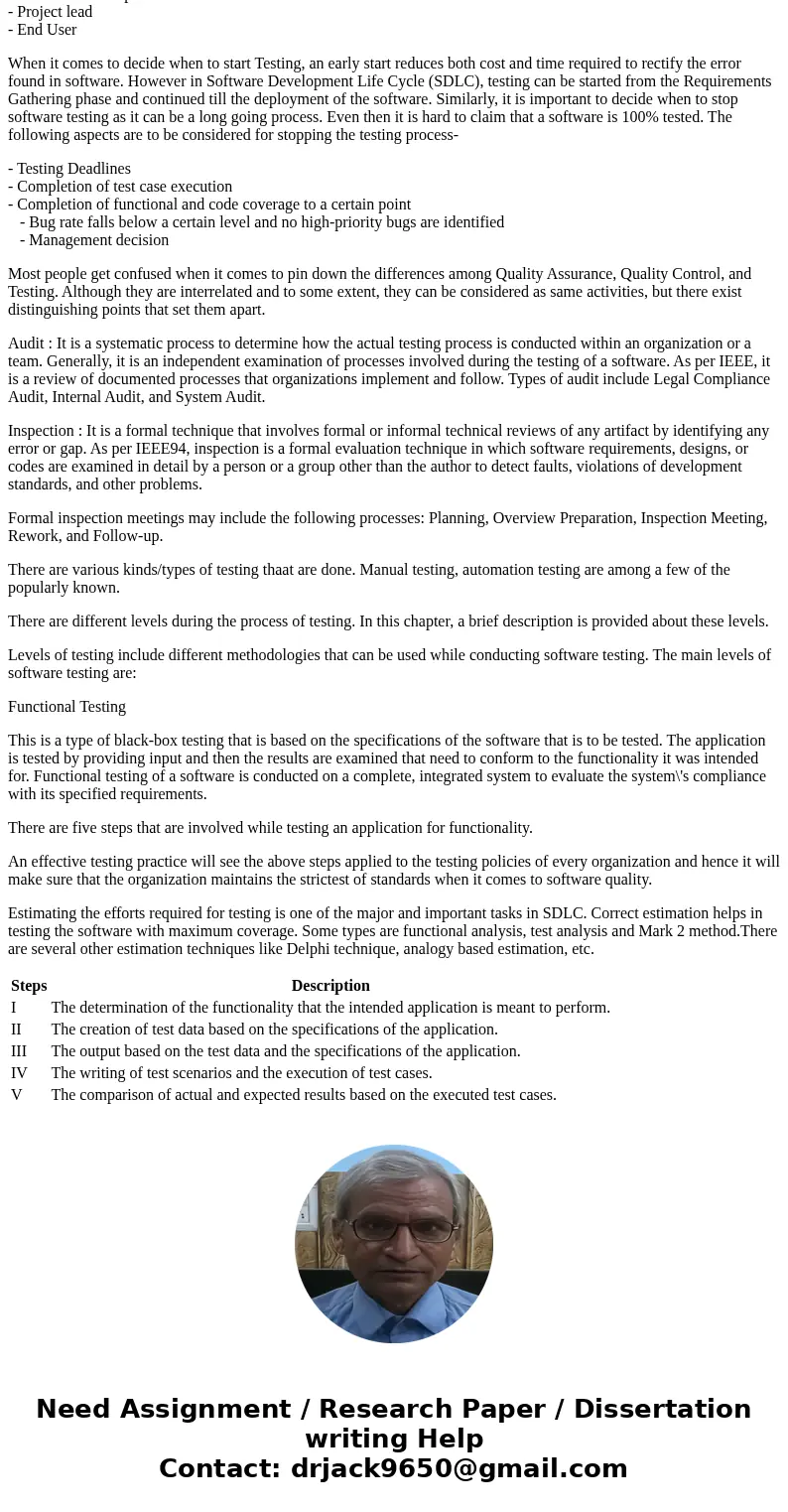Wrie a research paper on why software testing is a must to e
Wrie a research paper on why \"software testing is a must to ensure bug free software\"
Solution
Software testing is a process of executing a program or application with the intent of finding the software bugs. It can also be stated as the process of validating and verifying that a software program or application or product meets the business and technical requirements that guided it\'s design and development.
According to ANSI/IEEE 1059 standard, Testing can be defined as - A process of analyzing a software item to detect the differences between existing and required conditions (that is defects/errors/bugs) and to evaluate the features of the software item.
Who does Tesing is basically a question of what it depends on. It depends on the process and the associated stakeholders of the project(s). In the IT industry, large companies have a team with responsibilities to evaluate the developed software in context of the given requirements. Moreover, developers also conduct testing which is called Unit Testing.
The professionals involved in software testing are
- Software Testers
- Software Developers
- Project lead
- End User
When it comes to decide when to start Testing, an early start reduces both cost and time required to rectify the error found in software. However in Software Development Life Cycle (SDLC), testing can be started from the Requirements Gathering phase and continued till the deployment of the software. Similarly, it is important to decide when to stop software testing as it can be a long going process. Even then it is hard to claim that a software is 100% tested. The following aspects are to be considered for stopping the testing process-
- Testing Deadlines
- Completion of test case execution
- Completion of functional and code coverage to a certain point
- Bug rate falls below a certain level and no high-priority bugs are identified
- Management decision
Most people get confused when it comes to pin down the differences among Quality Assurance, Quality Control, and Testing. Although they are interrelated and to some extent, they can be considered as same activities, but there exist distinguishing points that set them apart.
Audit : It is a systematic process to determine how the actual testing process is conducted within an organization or a team. Generally, it is an independent examination of processes involved during the testing of a software. As per IEEE, it is a review of documented processes that organizations implement and follow. Types of audit include Legal Compliance Audit, Internal Audit, and System Audit.
Inspection : It is a formal technique that involves formal or informal technical reviews of any artifact by identifying any error or gap. As per IEEE94, inspection is a formal evaluation technique in which software requirements, designs, or codes are examined in detail by a person or a group other than the author to detect faults, violations of development standards, and other problems.
Formal inspection meetings may include the following processes: Planning, Overview Preparation, Inspection Meeting, Rework, and Follow-up.
There are various kinds/types of testing thaat are done. Manual testing, automation testing are among a few of the popularly known.
There are different levels during the process of testing. In this chapter, a brief description is provided about these levels.
Levels of testing include different methodologies that can be used while conducting software testing. The main levels of software testing are:
Functional Testing
This is a type of black-box testing that is based on the specifications of the software that is to be tested. The application is tested by providing input and then the results are examined that need to conform to the functionality it was intended for. Functional testing of a software is conducted on a complete, integrated system to evaluate the system\'s compliance with its specified requirements.
There are five steps that are involved while testing an application for functionality.
An effective testing practice will see the above steps applied to the testing policies of every organization and hence it will make sure that the organization maintains the strictest of standards when it comes to software quality.
Estimating the efforts required for testing is one of the major and important tasks in SDLC. Correct estimation helps in testing the software with maximum coverage. Some types are functional analysis, test analysis and Mark 2 method.There are several other estimation techniques like Delphi technique, analogy based estimation, etc.
| Steps | Description |
|---|---|
| I | The determination of the functionality that the intended application is meant to perform. |
| II | The creation of test data based on the specifications of the application. |
| III | The output based on the test data and the specifications of the application. |
| IV | The writing of test scenarios and the execution of test cases. |
| V | The comparison of actual and expected results based on the executed test cases. |


 Homework Sourse
Homework Sourse